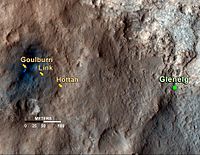Hottah is a rock outcrop on the surface of Aeolis Palus, between Peace Vallis and Aeolis Mons ("Mount Sharp"), in Gale crater on the planet Mars.[1][2][3]
 "Hottah" rock outcrop on Mars - an ancient streambed[1][2][3] viewed by the Curiosity rover (September 12, 2012, white balanced) (close-up) (3-D version). | |
| Feature type | Rock outcrop |
|---|---|
| Coordinates | 4°35′S 137°26′E / 4.59°S 137.44°E |

The outcrop was encountered by the Curiosity rover on the way from Bradbury Landing to Glenelg Intrigue on September 14, 2012 (the 39th sol of the mission), and was named after Hottah Lake, the sixth largest lake in the Northwest Territories, Canada. The "approximate" site coordinates are: 4°35′S 137°26′E / 4.59°S 137.44°E.
The outcrop is a well-sorted gravel conglomerate, containing well-rounded, smooth, abraded pebbles. Occasional pebbles up to a few centimeters across are embedded in amongst a matrix of finer rounded particles, up to a centimeter across. It has been interpreted as a fluvial sediment, deposited by a vigorously flowing stream, probably between ankle and waist deep. This stream is part of an ancient alluvial fan, which descends from the steep terrain at the rim of Gale crater across its floor.[2]

See also
editReferences
edit- ^ a b Brown, Dwayne; Cole, Steve; Webster, Guy; Agle, D.C. (September 27, 2012). "NASA Rover Finds Old Streambed On Martian Surface". NASA. Archived from the original on May 13, 2020. Retrieved September 28, 2012.
- ^ a b c NASA's Curiosity Rover Finds Old Streambed on Mars. NASA. September 27, 2012. Retrieved September 28, 2012 – via YouTube.
- ^ a b Chang, Alicia (September 27, 2012). "Mars rover Curiosity finds signs of ancient stream". AP News. Retrieved September 27, 2012.